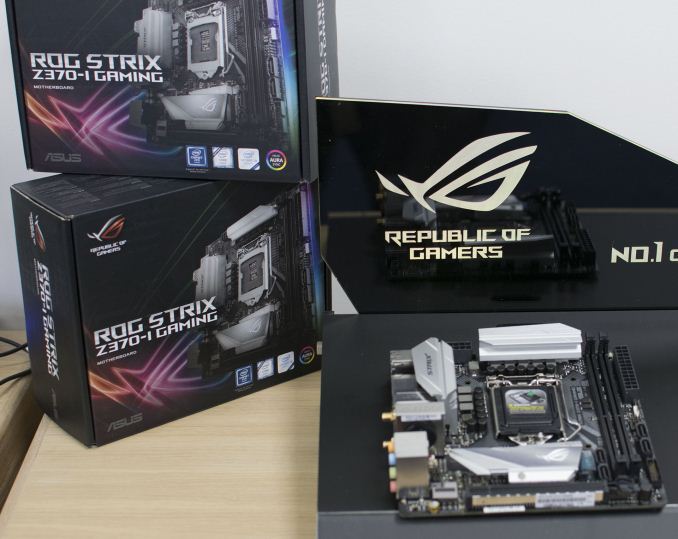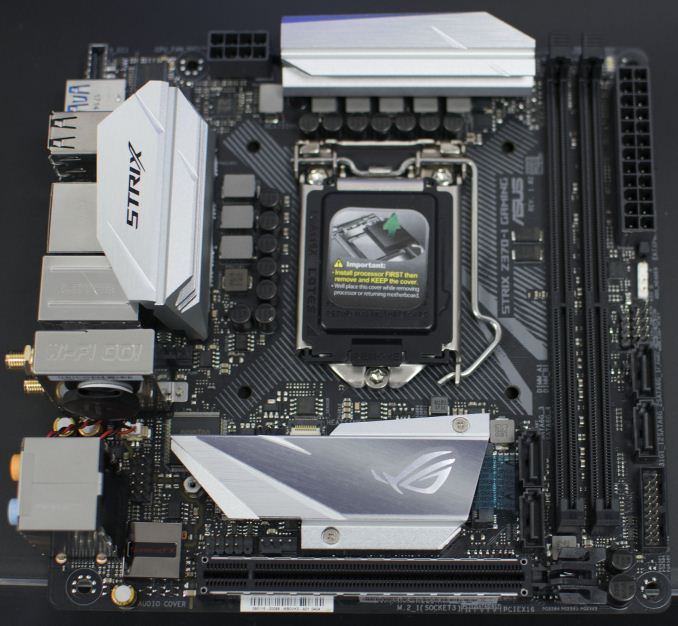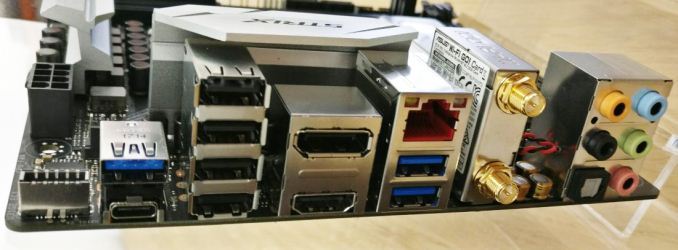Analyzing Z370 for Intel's 8th Generation Coffee Lake: A Quick Look at 50+ Motherboards
by Ian Cutress, Anton Shilov, Joe Shields & Gavin Bonshor on October 20, 2017 2:00 PM ESTASUS ROG STRIX Z370-I Gaming
Having spoken to ASUS at a recent event, there are no current plans to release a new Maximus Impact ITX offering to the market on Z370, so users specifically looking for an ASUS option will have to make do with the Strix Z370-I Gaming for the smaller form factor.
With this being an ITX form factor motherboard, certain and very obvious sacrifices have been made to cut down the size, but aside from fewer PCIe slots and a couple of SATA ports having been removed, the feature set is certainly far from small. The Z370-I has a single full-length PCIe 3.0 x16 slot which features the SafeSlot reinforcement, and in design terms, it is very similar to the Z370-E in styling and features new light silver metallic heat sinks.
Only two full-size memory slots can realistically fit onto an ITX form factor board - in recent years we have seen motherboard vendors push one memory slot per channel (1 DPC) designs on ATX boards as they can afford better performance through higher frequency margins, and ITX boards can get these benefits naturally: ASUS have rated the Strix Z370-I Gaming highly with support for up to DDR4-4333, memory controller on the CPU depending.
With storage, the Z370-I Gaming has four SATA ports, which are set upright out of the board with a pair on the edge outside of the DRAM and the second pair just inside, with this latter group potentially affected by large memory heatsinks, a large GPU cooler backplate, or a large CPU cooler. There is also two M.2 PCIe 3.0 x4 slots, one of which is neatly tucked under the main silver heat sink, and the other is placed on the rear of the board.
For audio, the Strix Z370-I Gaming like all the other Strix and Maximus Z370 boards utilizes the Realtek ALC1220 codec. The audio PCB segment uses gold Nichon Japanese audio capacitors, and the codec features a small EMI shield to protect from interference. Video support on the rear comes via DisplayPort and HDMI, and networking from an Intel I219-V gigabit Ethernet controller and an 802.11ac WiFi module.
The rear IO board has three USB 3.1 10 Gbps Type-A ports, a Type-C port, and four USB 2.0 Type-A ports. Headers on the board offer another USB 3.1 10Gbps port and four USB 2.0 ports. The small ITX form factor isn’t known for being rich in the way of fan headers, and on this board there are two regular 4-pin fan headers, a single header dedicated to AIO CPU coolers. There is also a single thermal sensor header.
It might be strange to think that ASUS ROG has started omitting Maximus Impact boards from the range - it would mean that ASUS has shifted focus away from high-performance ITX motherboards. The Impact boards were always over-engineered, which might be related to the delay, or ASUS might be saving it depending on market potential.













83 Comments
View All Comments
weevilone - Wednesday, October 25, 2017 - link
Notable that though the new boards are often very similar to their Z270 predecessors, Asus has dropped Thunderbolt 3 support from the Maximus X Hero board.masouth - Thursday, October 26, 2017 - link
ASUS ROG Z370 Maximus X Hero"....new metallic heat sinks that are an upgrade over the plastic heatsinks found on the Z270 version"
Please excuse my ignorance because I didn't own a ROG Z270 mb but...plastic HEAT SINKS? Not shrouds or decoration over a heat sink but the actual heat sinks themselves? That's either wrong, they performed their job pretty poorly, or plastic resins have advanced a lot farther in thermal conductivity (and cost for such) than I realized.
flowrush - Sunday, November 19, 2017 - link
"The other main distinguishable feature is the inclusion of integrated 802.11ac Wi-Fi with an antenna (that can only be described as a shark fin) found on the F."The above is incorrect in the article. The integrated Wi-Fi module with antenna is found on the E not the F.
Coldgame - Saturday, November 25, 2017 - link
I'm looking to build a rig with the Z370 Gaming ITX/ac, a GTX-1070 card and an Apple Thunderbolt Display.The review states:
"The key difference in the support between the two boards is going to be the Thunderbolt 3 port on the Gaming-ITX. This port supports video outputs..."
So, can anyone confirm or deny that video generated by the GTX-1070 can be output through the onboard Thunderbolt 3 port?
hanselltc - Sunday, December 3, 2017 - link
Looking forward to low-middle end mITX choices from this platform. It'll probably be paired with a 8100/8300 and be my secondary machine.Roen - Sunday, February 4, 2018 - link
Where are the 10 Gbps ports on the back? They all look like 5 Gbps ports, even the Type C.rbarak - Wednesday, February 21, 2018 - link
Is anyone using the Z370-P on Linux with two screens?I built a new machine based on the Z370-P, and both the DVI and the HDMI connected screens show the same image, and the RHEL7 setup/displays show only one Unknown Display.
I follwed the advice on stackexchange, and added this line:
$ grep GRUB_CMDLINE_LINE_DEFAULT /etc/default/grub
GRUB_CMDLINE_LINE_DEFAULT="i915.alpha_support=1"
Then I did:
sudo grub2-mkconfig -o "$(readlink /etc/grub2.conf)"
And rebooted, but still, the two displays are not shown.
dromoxen - Wednesday, May 9, 2018 - link
Shocked to see that both the Asrock mitx boards are "szie=ATX" .. LOLThe addition of Tunderbolt sure seems to add a hefty premium £120 vs £160 , luckily I can do without.
Kroebo - Sunday, October 7, 2018 - link
Sadly, I discovered that the ZUG Gaming PLUS doesn't support SLI.trag - Tuesday, January 15, 2019 - link
On the ASrock Z370M Pro4 the M.2 slot information is backwards. Both slots support NVME. One slot also supports SATA. As written, "The first M.2 slot is SATA only while the second supports PCIe." it seems to say that one slot is SATA only and the other slot is PCIe (NVME) only.